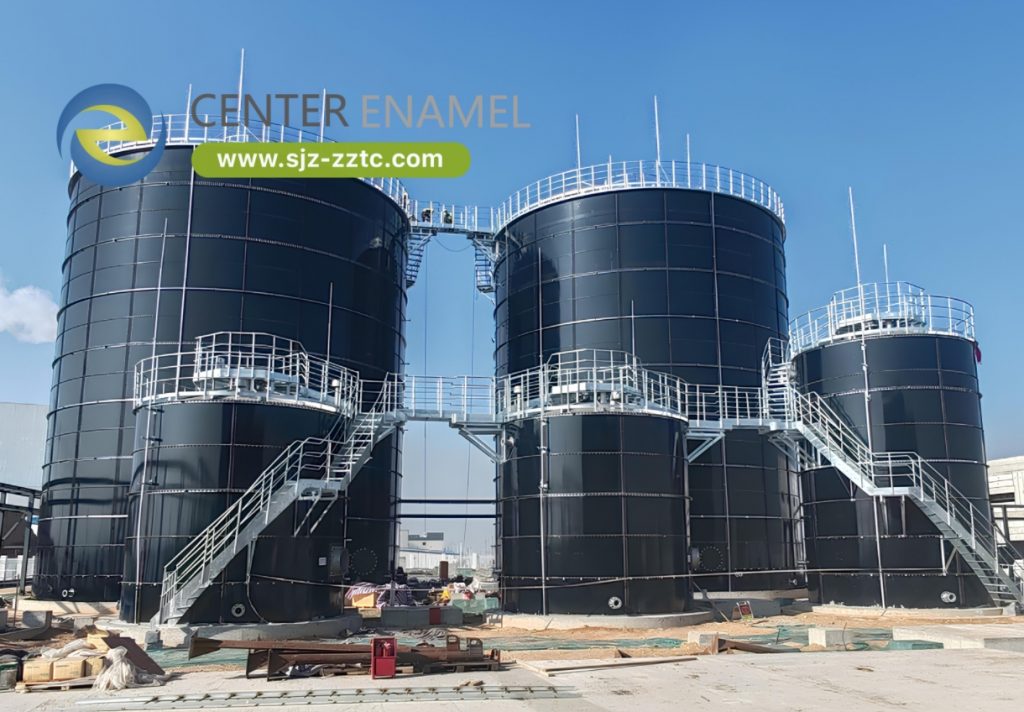UASB Reactors for Petrochemical Wastewater Treatment | Center Enamel

The petrochemical industry faces significant challenges in managing complex wastewater streams, which contain high concentrations of organic pollutants, chemicals, and suspended solids. To address these challenges, Upflow Anaerobic Sludge Blanket (UASB) reactors have emerged as an effective and sustainable solution for wastewater treatment. Center Enamel offers advanced UASB reactor systems designed specifically for the petrochemical sector, ensuring efficient pollutant removal, energy recovery, and long-term operational reliability.
UASB reactors operate on the principles of anaerobic digestion, where a dense microbial sludge blanket is maintained within the reactor. As wastewater flows upward through this sludge blanket, microorganisms break down organic contaminants in the absence of oxygen. This biological process converts complex organic compounds into methane-rich biogas and simpler end products. The design of the UASB reactor promotes contact between the wastewater and the microbial community, thereby achieving high rates of organic matter degradation.
Key components of the UASB reactor include:
- Inlet Zone: Where influent wastewater is introduced at the bottom of the reactor, ensuring uniform distribution and minimizing short-circuiting.
- Sludge Blanket: A dense, granular microbial community that is responsible for the anaerobic degradation of organic pollutants.
- Gas-Liquid-Solid Separation Zone: Located at the top of the reactor, this zone allows for the separation of biogas, treated effluent, and sludge, ensuring that each component is effectively managed.
- Effluent Collection System: Extracts the treated wastewater for further polishing or discharge, while retaining sufficient biomass within the reactor.
Advantages for Petrochemical Wastewater Treatment
Petrochemical wastewater often presents a complex matrix of contaminants, including high chemical oxygen demand (COD), phenols, and other refractory compounds. UASB reactors offer several advantages that make them particularly suited for this application:
- High Organic Loading Rates:
UASB reactors can handle high concentrations of organic pollutants due to the high microbial density within the sludge blanket. This capability is critical for petrochemical wastewater, which typically has a high organic load. - Energy Recovery:
The anaerobic digestion process produces biogas, primarily composed of methane. This biogas can be captured and used as a renewable energy source to offset operational costs or generate additional revenue. Energy recovery is an attractive feature for industries looking to improve their sustainability profile. - Reduced Sludge Production:
Compared to aerobic treatment processes, UASB reactors generate less excess sludge. This reduction in sludge production decreases disposal costs and simplifies overall plant operations. - Operational Efficiency:
UASB reactors have a relatively small footprint and require less energy input for operation compared to conventional treatment systems. Their simplicity in design and operation makes them both cost-effective and reliable for continuous industrial applications. - Adaptability to Variable Wastewater Characteristics:
The inherent flexibility of the UASB process allows it to adapt to fluctuations in wastewater composition and flow rates. This resilience is essential in petrochemical operations, where wastewater characteristics can vary due to changes in production processes.
Engineering and Design Excellence by Center Enamel
Center Enamel leverages decades of expertise in advanced storage and reactor systems to design UASB reactors that meet the rigorous demands of the petrochemical industry. Our approach is characterized by:
- Precision Engineering:
Advanced computational models and pilot-scale testing ensure that each reactor is optimized for maximum efficiency and durability. The design parameters, including reactor geometry, hydraulic retention time, and sludge retention, are tailored to the specific needs of petrochemical wastewater. - High-Quality Materials:
Given the aggressive nature of petrochemical effluent, materials used in the construction of UASB reactors must be resistant to corrosion and chemical degradation. Center Enamel utilizes high-grade materials that withstand harsh operating conditions and ensure long-term performance. - Customization:
Recognizing that wastewater characteristics can vary significantly between facilities, our UASB reactors are designed to be customizable. We work closely with clients to develop reactors that are specifically engineered to meet their wastewater treatment goals, whether through modifications in reactor volume, configuration, or integration with ancillary treatment processes. - Sustainable Operations:
The biogas generated in the UASB process represents a renewable energy resource. Center Enamel’s systems are designed to maximize biogas recovery, contributing to the sustainability initiatives of petrochemical facilities. The integration of energy recovery systems not only reduces the environmental footprint but also provides economic benefits by lowering operational costs.
Implementing UASB reactors for petrochemical wastewater treatment can lead to significant economic and environmental benefits. By reducing the organic load and producing renewable biogas, facilities can achieve a lower operating cost and enhance energy efficiency. Moreover, the reduction in sludge production minimizes the environmental burden associated with sludge disposal. From an environmental standpoint, capturing methane that would otherwise be released into the atmosphere contributes to reduced greenhouse gas emissions, supporting global efforts to mitigate climate change.
For petrochemical plants seeking an advanced, durable, and efficient treatment solution, Center Enamel offers UASB reactor systems designed to meet and exceed industry standards. Contact Center Enamel to learn more about our tailored solutions and how our technology can enhance the sustainability and efficiency of your wastewater treatment operations.
